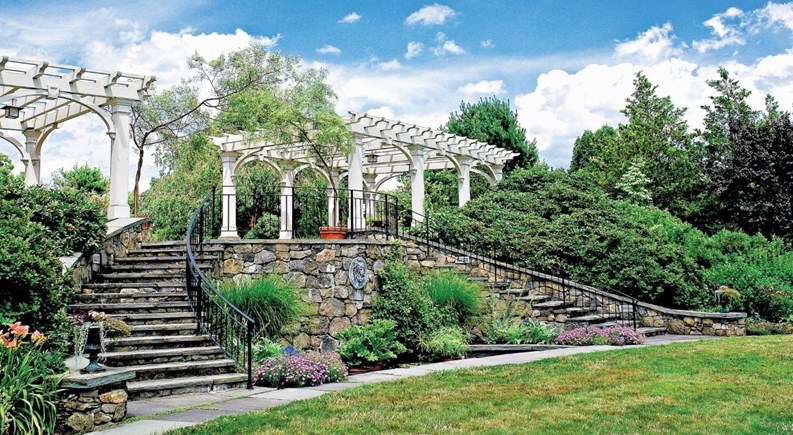The bulldozers are clanging and tradesmen are busy pounding away, but in a few short months peace and quiet will return to Tower Hill Botanic Garden in Boylston, Massachusetts.
All the noise is part of a $7.5 million expansion under way at the 132-acre European-style garden and educational facility, about 30 miles west of Boston. When the work is finished in August, the facility will feature a new Winter Garden, a lemon-themed greenhouse, an expanded restaurant and event facilities.
The improvements are designed to accommodate an increased number of visitors – from 50,000 currently to 150,000 a year –while “maintaining the quality of the visitor experience that we [now] have,” says Executive Director John Trexler.
The increased number of visitors will find plenty of intriguing attractions inall four seasons, says Trexler. “We’ve pretty much covered our bases as far as developing a diverse offering that is true to our mission, which is plants,” he says.
New Winter Garden and Limonaia
At the heart of the expansion are the new Winter Garden and Limonaia.
The 14,000-square-foot Winter Garden was designed “to capture the essence of New England, which is the vocabulary of stone walls,” says Missy Marshall, with MTR Landscape Architects, LLC, in Pittsburgh, Penn-sylvania. To flesh out that goal, local granite fieldstone was used to line the walls of the sunken garden, explains Marshall, whose firm designed the Winter Garden.
At the center of the garden is a heated pool and fountains modeled after Hadrian’s Villa, a second century summer retreat in Tivoli, Italy, built for Roman Emperor Hadrian. Placed in the pool are two bronze turtles spouting water from their mouths, produced by local sculptor Priscilla Deichmann. The fountains will be able to run year-round, giving the secludedarea “dramatic interest,” says Trexler.
Because the garden is sunken and enclosed by buildings on four sides, it has its own warmer microclimate and can take advantage of plants that bloom“really, really early in the season,” says Marshall.
According to Trexler, the Winter Garden will feature woody plants like paperbark maple, colored twig dogwood and evergreens with weeping habits that have outstanding form, color or texture.
Adding to the woody plants are herbaceous shrubs that bloom as early as February as well as bulbs that pop up in very early spring.
The Winter Garden, says Trexler, “will show people that in this part of the world, there’s no reason why a garden can’t be as beautiful in the dead of winter as in July.”
Visitors won’t necessarily have to go into the Winter Garden to enjoy its beauty during cold months, says Trexler, noting that it’s surrounded by generous glass views from adjoining buildings. “It’s meant to be looked at really from the inside out,” he notes.
The new 3,500 square foot Limonaia (Italian for lemon house) will complement the existing Orangerie (French for orange house), and feature a mix of lemon trees and camellias, the latter culled from Tower Hill’s extensive collection of the species. Like the Orangerie, the lightly scented Limonaiawill provide a space for events and a beautiful retreat from the stresses of daily life.
Expanded Facilities
On the facilities side, Tower Hill is installing an expanded 10,000-square foot events lawn that can accommodatetents and events (typically weddings) with as many as 250 guests. The lawn will host the annual Tower Hill Plant Sale and Gardner’s Emporium.
Also being built is a new kitchen in the main Stoddard Building that will service functions and an expanded Twigs Cafe, which will be moved from the Stoddard Building to a new spot directly east of the Winter Garden. Diners at Twigs can admire the gardenthrough a curved glass wall.
In the Stoddard Building, the reception area has been enlarged by 1,300 square feet, which will provide a better entry point for the increased number of visitors expected to at TowerHill, says Trexler. Improvements to the Great Hall will make it a better venue for the variety of flower shows, concerts and receptions offered at Tower Hill, he says.
Improved handicapped access to classrooms will help the facility better fulfill its central mission of education, says Betsy DeMallie, recent president of the Worcester County HorticulturalSociety Board of Trustees, which oversees Tower Hill. “Education is at the heart of our mission, whether it’s classrooms or the experience of going out and looking at gardens and seeing how things grow,” says DeMallie, whose term ended this March.
A “Major Player”
The expansion will attract more visitors while adding to the garden’s credentials as a major regional attraction, says DeMallie.
The visitor experience and the quality of the gardens have made Tower Hill “a player on the national stage,” says DeMallie, noting it has won a number of awards from Garden Club of America.
Trexler notes that Tower Hill doesn’t compete with – but complements – other major horticultural attractions in the area like The Arnold Arboretum in Jamaica Plain, Massachusetts, and Garden in the Woods in Framingham, Massachusetts. “Regionally, in the central New England region, Tower Hill is by far the most conspicuous (of the facilities),” he says.
21stCentury Stress Reducer
Trexler foresees an expanded Tower Hill becoming even more important to New England residents facing hectic, noisy lives. “If you live in a condominium and you’re living in close quarters with other people, to come toa place like this is liberating,” he says.
Visitors to Tower Hill find “it’s big, and it’s very beautiful, and it has a lot of lovely things. And it’s very intelligent, it’s very well thought out. It’s quitea contrast to what people experience in the daily routine, so when they come here, it’s like, ‘Wow, this place is very beautiful. Take a look at this place! It’s amazing’… It's not something that we experience every day.”
When the expansion is completed inAugust, visitors will be able to experience the spectacular beauty of all the gardens during a grand opening. “It will be free and open to the public,” says Trexler.
Jim Douglass is the managing editor at New England Condominium magazine.







Leave a Comment